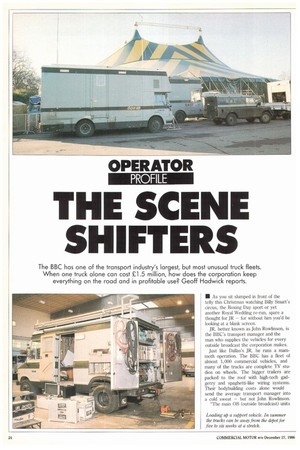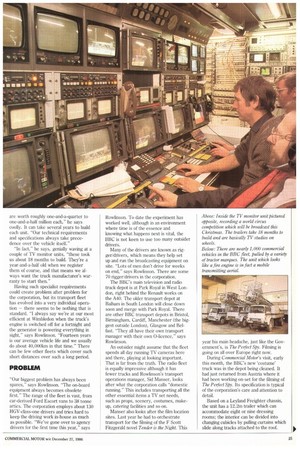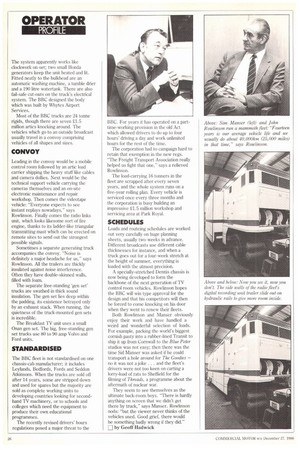THE Sc SHIFT RS
Page 26

Page 27

Page 28

If you've noticed an error in this article please click here to report it so we can fix it.
The BBC has one of the transport industry's largest, but most unusual truck fleets. When one truck alone can cost £1.5 million, how does the corporation keep everything on the road and in profitable use? Geoff Hadwick reports.
• As you sit slumped in front of the telly this Christmas watching Billy Smart's circus, the Boxing Day sport or yet another Royal Wedding re-run, spare a thought for JR — for without him you'd be looking at a blank screen.
JR, better known as John Rowlinson, is the BBC's transport manager and the man who supplies the vehicles for every outside broadcast the corporation makes.
Just like Dallas's JR, he runs a mammoth operation. The BBC has a fleet of almost 1,000 commercial vehicles, and many of the trucks are complete TV studios on wheels. The bigger trailers are packed to the roof with high-tech gadgetry and spaghetti-like wiring systems. Their bodybuilding costs alone would send the average transport manager into a cold sweat — but not John Rowlinson.
-The main OB (outside broadcast) units
are worth roughly one-and-a-quarter to one-and-a-half million each," he says coolly. It can take several years to build each unit. "Our technical requirements and specifications always take precedence over the vehicle itself."
in fact," he says, genially waving at a couple of TV monitor units, "these took us about 18 months to build. They're a year-and-a-half old when we register them of course, and that means we always want the truck manufacturer's warranty to start then."
Having such specialist requirements could create problem after problem for the corporation, but its transport fleet has evolved into a very individual operation — there seems to be nothing that is standard. "I always say we're at our most efficient at Wimbledon when the truck's engine is switched off for a fortnight and the generator is powering everything in sight," says Rowlinson. "Fourteen years is our average vehicle life and we usually do about 40,000km in that time." There can be few other fleets which cover such short distances over such a long period.
PROBLEM
"Our biggest problem has always been spares," says Rowlinson. "The on-board equipment always becomes obsolete first." The range of the fleet is vast, from car-derived Ford Escort vans to 38 tonne artics. The corporation employs about 130 FIGV-class-one drivers and tries hard to keep the driving work in-house as much as possible. "We've gone over to agency drivers for the first time this year," says
Rowlinson. To date the experiment has worked well, although in an environment where time is of the essence and
knowing what happens next is vital, the BBC is not keen to use too many outsider drivers.
Many of the drivers are known as rigger/drivers, which means they help set up and run the broadcasting equipment on site. "Lots of men don't drive for weeks on end," says Rowlinson. There are some 70 rigger/drivers in the corporation.
The BBC's main television and radio truck depot is at Park Royal in West London, right behind the Renault works on the A40. The older transport depot at Balham in South London will close down soon and merge with Park Royal. There are other BBC transport depots in Bristol, Birmingham, Cardiff, Manchester (the biggest outside London), Glasgow and Belfast. "They all have their own transport manager with their own 0-licence," says Rowlinson.
An outsider might assume that the fleet spends all day running TV cameras here and there, playing at looking important. That is far from the truth. The radio fleet is equally impressive although it has fewer trucks and Rowlinson's transport operations manager, Ski Manser, looks after what the corporation calls "domestic running." This includes transporting all the other essential items a TV set needs, such as props, scenery, costumes, makeup, catering facilities and so on.
Manser also looks after the film location sites. Last year he had to orchestrate transport for the filming of the F Scott Fitzgerald novel Tender is the Night. This
year his main headache, just like the Government's, is The Perfect Spy. Filming is going on all over Europe right now.
During Commercial Motor's visit, early this month, the BBC's new 'costume' truck was in the depot being cleaned. It had just returned from Austria where it had been working on-set for the filming of The Perfect Spy. Its specification is typical of the corporation's care and attention to detail.
Based on a Leyland Freighter chassis, the unit has a 12.2m trailer which can accommodate eight or nine dressing rooms; the interior can be divided into chanOig cubicles by pulling curtains which slide along tracks attached to the roof. The system apparently works like clockwork on-set; two small Honda generators keep the unit heated and lit. Fitted neatly to the bulkhead are an automatic washing machine, a tumble drier and a 190 litre watertank. There are also fail-safe cut-outs on the truck's electrical system. The BBC designed the body which was built by Whytes Airport Services.
Most of the BBC trucks are 24 tonne rigids, though there are seven £1.5 million artics knocking around. The vehicles which go to an outside broadcast usually travel in a convoy comprising vehicles of all shapes and sizes.
CONVOY
Leading in the convoy would be a mobile control room followed by an artic load carder shipping the heavy stuff like cables and camera dollies. Next would be the technical support vehicle carrying the cameras themselves and an on-site electronic maintenance and repair workshop. Then comes the videotape vehicle: "Everyone expects to see instant replays nowadays," says Rowlinson. Finally comes the radio links unit, which looks likesome sort of fire engine, thanks to its ladder-like triangular transmitting mast which can be erected on remote sites to send out the strongest possible signals.
Sometimes a separate generating truck accompanies the convoy. "Noise is definitely a major headache for us," says Rowlinson. All the trailers are thickly insulated against noise interference. Often they have double-skinned walls, filled with foam.
The separate free-standing 'gen set' trucks are swathed in thick sound insulation. The gen set lies deep within the padding, its existence betrayed only by an exhaust stack. When running, the quietness of the truck-mounted gen sets is incredible.
The Breakfast TV unit uses a small Onan gen set. The big, free-standing gen set trucks use 80 to 90 amp Volvo and Ford units.
STANDARDISED
The BBC fleet is not standardised on one chassis-cab manufacturer; it includes Leylands, Bedforcls, Fords and Seddon Atkinsons. When the trucks are sold off after 14 years, some are stripped down and used for spares but the majority are sold as complete working units to developing countries looking for secondhand TV machinery, or to schools and colleges which need the equipment to produce their own educational programmes.
The recently revised drivers' hours regulations posed a major threat to the BBC. For years it has operated on a parttime-working provision in the old Act which allowed drivers to do up to four hours' driving a day and work unlimited hours for the rest of the tune.
The corporation had to campaign hard to retain that exemption in the new regs. "The Freight Transport Association really helped us fight that one," says a relieved Rowlinson.
The load-carrying 16 tonners in the fleet are scrapped after every seven years, and the whole system runs on a five-year rolling plan. Every vehicle is serviced once every three months and the corporation is busy building an impressive £1.5 million workshop and servicing area at Park Royal.
SCHEDULES
Loads and routeing schedules are worked out very carefully on huge planning sheets, usually two weeks in advance. Different broadcasts use different cable thicknesses for instance, and when a truck goes out for a four-week stretch at the height of summer, everything is loaded with the utmost precision.
A specially-stretched Dennis chassis is now being developed to form the backbone of the next generation of TV control room vehicles. Rowlinson hopes the BBC will win type approval for the design and that his competitors will then be forced to come knocking on his door when they went to renew their fleets.
Both Rowlinson and Manser obviously enjoy their work and have handled a weird and wonderful selection of loads. For example, packing the world's biggest cornish pasty into a rubber-lined Transit to ship it up from Cornwall to the Blue Peter studios was not easy; then there was the time Sid Manser was asked if he could transport a hole around for The Goodies — no it was not a joke. . . and the fleet's drivers were not too keen on carting a lorry-load of rats to Sheffield for the filming of Threads, a programme about the aftermath of nuclear war.
They seem to see themselves as the ultimate back-room boys. "There is hardly anything on screen that we didn't get there by truck," says Manser. Rowlinson nods: "but the viewer never thinks of the vehicles used. Good grief, there would be something badly wrong if they did."
by Geoff Hadwick




















































